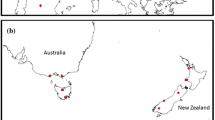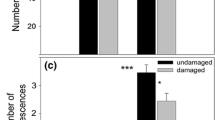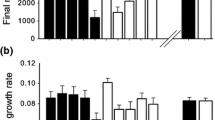Abstract
The successful spread of invasive plants may result from an evolutionary shift in resource allocation from defence to growth due to release from enemies, as proposed by the ‘evolution of increased competitive ability’ hypothesis (EICA). The crucifer Lepidium draba was used to test this hypothesis, measuring growth and levels of glucosinolates and myrosinase of leaves as constitutive defence parameters. Individuals from 21 populations of the native (Europe) and the invasive range (North-America) were grown under common greenhouse conditions. According to the EICA hypothesis it was predicted that plants from the invasive range might show stronger growth and have lower levels of defence as a result of selection favouring such genotypes. There was significant variation between populations in shoot, root, total biomass, and number of ramets of 3-month-old plants but no difference due to origin from both continents. The main glucosinolate p-hydroxybenzyl glucosinolate was significantly higher in seedlings of the invasive range while myrosinase activity was higher in old plants of the invasive range. Therefore, the EICA hypothesis does not hold, however, alternatively there is evidence for selection favouring stronger defence in the invasive range. The binary defence system of this crucifer is discussed with respect to the degree of specialisation of potential herbivores.
Similar content being viewed by others
References
N. Agerbirk C.B. Olsen J.K. Nielsen (2001a) ArticleTitleSeasonal variation in leaf glucosinolates and insect resistance in two types of Barbarea vulgaris ssp. arcuata Phytochemistry 58 91–100 Occurrence Handle10.1016/S0031-9422(01)00151-0
N. Agerbirk B.L. Petersen C.E. Olsen B.A. Halkier J.K. Nielsen (2001b) ArticleTitle1,4-Dimethoxyglucobrassicin in Barbarea and 4-hydroxyglucobrassicin in Arabidopsis and Brassica J. Agric. Food Chem. 49 1502–1507 Occurrence Handle10.1021/jf001256r
A.A. Agrawal P.M. Kotanen (2003) ArticleTitleHerbivores and the success of exotic plants: A phylogenetically controlled experiment Ecol. Lett. 6 712–715 Occurrence Handle10.1046/j.1461-0248.2003.00498.x
A.A. Agrawal N.S. Kurashige (2003) ArticleTitleA role for isothiocyanates in plant resistance against the specialist herbivore Pieris rapae J. Chem. Ecol. 29 1403–1415 Occurrence Handle10.1023/A:1024265420375 Occurrence Handle12918924
I.A. Al-Shehbaz K. Mummenhoff (2002) ArticleTitleCardaria, Coronopus, and Stroganowia are united within Lepidium (Brassicaceae) Novon 12 5–11
E. Bartlet M.M. Blight P. Lane I.H. Williams (1997) ArticleTitleThe responses of the cabbage seed weevil Ceutorhynchus assimilis to volatile compounds from oilseed rape in a linear track olfactometer Entomol. Exp. Appl. 85 257–262 Occurrence Handle10.1023/A:1003140219888
P.A. Blau P. Feeny L. Contardo (1978) ArticleTitleAllylglucosinolate and herbivorous caterpillars, a␣contrast in toxicity and tolerance Science 200 1296–1298
B. Blossey R. Nötzold (1995) ArticleTitleEvolution of increased competitive ability in invasive nonindigenous plants: a hypothesis J. Ecol. 83 887–889
B. Blossey L.C. Skinner J. Taylor (2001) ArticleTitleImpact and management of purple loosestrife (Lythrum salicaria) in North America Biodivers. Conserv. 10 1787–1807 Occurrence Handle10.1023/A:1012065703604
R.P. Bodnaryk (1992) ArticleTitleEffects of wounding on glucosinolates in the cotyledons of oilseed rape and mustard Phytochemistry 31 2671–2677 Occurrence Handle10.1016/0031-9422(92)83609-3
R.P. Bodnaryk (1994) ArticleTitlePotent effect of jasmonates on indole glucosinolates in oilseed rape and mustard Phytochemistry 35 301–305 Occurrence Handle10.1016/S0031-9422(00)94752-6
R.P Bradburne R. Mithen (2000) ArticleTitleGlucosinolate genetics and the attraction of the aphid parasitoid Diaeretiella rapae to Brassica Proc. Roy. Soc. Lond. Ser. B 267 89–95 Occurrence Handle10.1098/rspb.2000.0971
P.D. Brown J.G. Tokuhisa M. Reichelt J. Gershenzon (2003) ArticleTitleVariation of glucosinolate accumulation among different organs and developmental stages of Arabidopsis thaliana Phytochemistry 62 471–481 Occurrence Handle10.1016/S0031-9422(02)00549-6 Occurrence Handle12620360
D.F. Cipollini (2002) ArticleTitleVariation in the expression of chemical defenses in Alliaria petiolata in the field and common garden Am. J. Bot. 89 1422–1430
Cipollini, D.F., Mbagwu, J., Barto, K., Hillstrom, C. and Enright, S. (2005). Expression of constitutive and inducible chemical defenses in native and invasive populations of Alliaria petiolata. J. Chem. Ecol. 31, 1255–1267
K. Dornberger V. Böckel J. Heyer C. Schönfeld M. Tonew E. Tonew (1975) ArticleTitleUntersuchungen über die Isothiocyanate Erysolin and Sulforaphan aus Cardaria draba L Pharmazie 30 792–796 Occurrence Handle1219798
S. Eriksson B. Ek J. Xue L. Rask J. Meijer (2001) ArticleTitleIdentification and characterization of soluble and insoluble myrosinase isoenzymes in different organs of Sinapis alba Physiol. Plant. 111 353–364 Occurrence Handle10.1034/j.1399-3054.2001.1110313.x Occurrence Handle11240920
A. Giamoustaris R. Mithen (1995) ArticleTitleThe effect of modifying the glucosinolate content of leaves of oilseed rape (Brassica napus ssp. oleifera) on its interaction with specialist and generalist pests Ann. Appl. Biol. 126 347–363
B.A. Halkier (1999) Glucosinolates R. Ikan (Eds) Naturally Occuring Glycosides John Wiley and Sons Ltd London 193–223
M. Haribal J.A.A. Renwick (2001) ArticleTitleSeasonal and population variation in flavonoid and alliarinoside content of Alliaria petiolata J. Chem. Ecol. 27 1585–1594 Occurrence Handle10.1023/A:1010406224265 Occurrence Handle11521398
Hinz, H.L. and Schwarzlaender, M. (2004). Comparing invasive plants from their native and exotic range: what can we learn for biological control. Weed Tech. 18, 1533–1541
R.M. Keane M.J. Crawley (2002) ArticleTitleExotic plant invasions and the enemy release hypothesis Trends Ecol. Evol. 17 164–170 Occurrence Handle10.1016/S0169-5347(02)02499-0
G.L. Kiemnec M.L. McInnis (2002) ArticleTitleHoary cress (Cardaria draba) root extract reduces germination and root growth of five plant species Weed Tech. 16 231–234
L. Larson G. Kiemnec T. Smergut (2000) ArticleTitleHoary cress reproduction in a sagebrush ecosystem J. Range Manage. 53 556–559
E.A. Leger K.J. Rice (2003) ArticleTitleInvasive California poppies (Eschscholzia californica Cham.) grow larger than native individuals under reduced competition Ecol. Lett. 6 257–264 Occurrence Handle10.1046/j.1461-0248.2003.00423.x
Q. Li S.D. Eigenbrode G.R. Stringham M.R. Thiagarajah (2000) ArticleTitleFeeding and growth of Plutella xylostella and Spodoptera eridania on Brassica juncea with varying glucosinolate concentrations and myrosinase activities J. Chem. Ecol. 26 2401–2419 Occurrence Handle10.1023/A:1005535129399
J. Ludwig-Müller B. Schubert K. Pieper S. Ihmig W. Hilgenberg (1997) ArticleTitleGlucosinolate content in susceptible and resistant chinese cabbage varieties during development of clubroot disease Phytochemistry 44 407–417 Occurrence Handle10.1016/S0031-9422(96)00498-0
R.N. Mack D. Simberloff W.M. Lonsdale H. Evans M. Clout F.A. Bazzaz (2000) ArticleTitleBiotic invasions: causes, epidemiology, global consequences, and control Ecol. Appl. 10 689–710
L.M. Manici L. Lazzeri S. Palmieri (1997) ArticleTitleIn vitro fungitoxic activity of some glucosinolates and their enzyme-derived products towards plant pathogenic fungi J. Agric. Food Chem. 45 2768–2773 Occurrence Handle10.1021/jf9608635
M. Matsuki (1996) ArticleTitleRegulation of plant phenolic synthesis: from biochemistry to ecology and evolution Aust. J. Bot. 44 613–634
S.J. Milton (2004) ArticleTitleGrasses as invasive alien plants in South Africa South African J. Sci. 100 69–75
C.E. Mitchell A.G. Power (2003) ArticleTitleRelease of invasive plants from fungal and viral pathogens Nature 421 625–627 Occurrence Handle10.1038/nature01317 Occurrence Handle12571594
C. Müller N. Agerbirk C.E. Olsen J.-L. Boevé U. Schaffner P.M. Brakefield (2001) ArticleTitleSequestration of host plant glucosinolates in the defensive hemolymph of the sawfly Athalia rosae J. Chem. Ecol. 27 2505–2516 Occurrence Handle10.1023/A:1013631616141 Occurrence Handle11789955
H. Müller-Schärer T. Steinger (2004) Predicting evolutionary change in invasive, exotic plants␣and its consequence for plant–herbivore interactions L.E. Ehler R. Sforza T. Mateille (Eds) Genetics, Evolution and Biological Control CABI Publishing Wellingford 137–162
H. Müller-Schärer U. Schaffner T. Steinger (2004) ArticleTitleEvolution in invasive plants: implications for biological control Trends Evol. Ecol. 19 417–422 Occurrence Handle10.1016/j.tree.2004.05.010
G.A. Mulligan J.N. Findlay (1974) ArticleTitleThe biology of Canadian weeds. 3, Cardaria draba, C. chalepensis, and C. pubescens Can. J. Plant Sci. 54 149–160
B.L. Petersen S. Chen C.H. Hansen C.E. Olsen B.A. Halkier (2002) ArticleTitleComposition and content of glucosinolates in developing Arabidopsis thaliana Planta 214 562–571 Occurrence Handle10.1007/s004250100659 Occurrence Handle11925040
M.J. Potter V.A. Vanstone K.A. Davies A.J. Rathjen (2000) ArticleTitleBreeding to increase the concentration of 2-phenylethyl glucosinolate in the roots of Brassica napus J. Chem. Ecol. 26 1811–1820 Occurrence Handle10.1023/A:1005588405774
J.R. Qasem (1994) ArticleTitleAllelopathic effect of white top (Lepidium draba) on wheat and barley Allelopath. J. 1 29–40
J.A.A. Renwick (2002) ArticleTitleThe chemical world of crucivores: lures, treats and traps Entomol. Exp. Appl. 104 35–42 Occurrence Handle10.1023/A:1021231732022
M. Rostás R. Bennett M. Hilker (2002) ArticleTitleComparative physiological responses in Chinese cabbage induced by herbivory and fungal infection J. Chem. Ecol. 28 2449–2463 Occurrence Handle10.1023/A:1021427917603 Occurrence Handle12564792
L.M. Schoonhoven T. Jermy J.J.A. Loon Particlevan (1998) Insect–Plant Biology. From Physiology to Evolution Chapman and Hall London
E. Siemann W.E. Rogers (2001) ArticleTitleGenetic differences in growth of an invasive tree species Ecol. Lett. 4 514–518 Occurrence Handle10.1046/j.1461-0248.2001.00274.x
D.H. Siemens S.H. Garner T. Mitchell-Olds R.M. Callaway (2002) ArticleTitleCost of defense in the context of plant competition: Brassica rapa may grow and defend Ecology 83 505–517
D.H. Siemens T. Mitchell-Olds (1996) ArticleTitleGlucosinolates and herbivory by specialists (Coleoptera: Chrysomelidae, Lepidoptera: Plutellidae): consequences of concentration and induced resistance Environ. Entomol. 25 1344–1353
D.H. Siemens T. Mitchell-Olds (1998) ArticleTitleEvolution of pest-induced defenses in Brassica plants: tests of theory Ecology 79 632–646
N. Stamp (2003) ArticleTitleOut of the quagmire of plant defense hypotheses Q. Rev. Biol. 78 23–55 Occurrence Handle10.1086/367580 Occurrence Handle12661508
K.A. Stowe (1998) ArticleTitleRealized defense of artificially selected lines of Brassica rapa: effects of quantitative genetic variation in foliar glucosinolate concentration Environ. Entomol. 27 1166–1174
K.F.M.J. Tierens B.P.H. Thomma M. Brouwer J. Schmidt K. Kistner A. Porzel B. Mauch-Mani B.P.A. Cammue W.F. Broekaert (2001) ArticleTitleStudy of the role of antimicrobial glucosinolate-derived isothiocyanates in resistance of Arabidopsis to microbial pathogens Plant Phys. 125 1688–1699 Occurrence Handle10.1104/pp.125.4.1688
N.M. Dam Particlevan L. Witjes A. Svatoš (2003) ArticleTitleInteraction between aboveground and belowground induction of glucosinolates in two wild Brassica species New Phytol. 161 801–810
E. Meijden Particlevan der (1996) ArticleTitlePlant defence, an evolutionary dilemma. Contrasting effects of (specialist and generalist) herbivores and natural enemies Entomol. Exp. Appl. 80 307–310 Occurrence Handle10.1007/BF00194780
C. Vincent R.K. Stewart (1984) ArticleTitleEffect of allyl isothiocyanate on field behavior of crucifer-feeding flea beetles (Coleoptera: Chrysomelidae) J. Chem. Ecol. 10 33–39 Occurrence Handle10.1007/BF00987641
A.J. Willis J. Memmott R.I. Forrester (2000) ArticleTitleIs there evidence for the post-invasion evolution of increased size among invasive plant species? Ecol. Lett. 3 275–283 Occurrence Handle10.1046/j.1461-0248.2000.00149.x
U. Wittstock D.J. Kliebenstein V. Lambrix M. Reichelt J. Gershenzon (2003) Glucosinolate hydrolysis and its impact on generalist and specialist insect herbivores J.T. Romeo (Eds) Recent Advances in Phytochemistry NumberInSeries37. Pergamon Amsterdam 101–125
Author information
Authors and Affiliations
Corresponding author
Rights and permissions
About this article
Cite this article
Müller, C., Martens, N. Testing Predictions of the ‘Evolution of Increased Competitive Ability’ Hypothesis for an Invasive Crucifer. Evol Ecol 19, 533–550 (2005). https://doi.org/10.1007/s10682-005-1022-0
Received:
Accepted:
Issue Date:
DOI: https://doi.org/10.1007/s10682-005-1022-0




